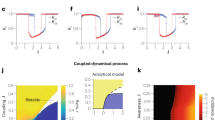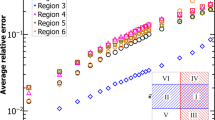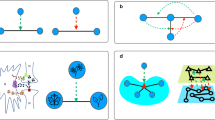Abstract
From critical infrastructure to physiology and the human brain, complex systems rarely occur in isolation. Instead, the functioning of nodes in one system often promotes or suppresses the functioning of nodes in another. Structural interdependence—that is, when the functionality of the nodes is determined exclusively by connectivity between layers—can be characterized via percolation processes on interdependent networks. However, modelling more general interactions between dynamical systems has remained an open problem. Here, we present a dynamic dependency framework that can capture interdependent and competitive interactions between dynamic systems, which we use to study synchronization and spreading processes in multilayer networks with interacting layers. By developing a mean-field theory, which we verify by simulations, we find coupled collective phenomena, including multistability, regions of coexistence, and macroscopic chaos. In interdependent dynamics, in particular, we observe hysteretic behaviours with abrupt (hybrid and explosive) transitions, that exhibit universal features that match those emerging from interdependent percolation. This dynamic dependency framework provides a powerful tool with which to improve our understanding of many of the interacting complex systems surrounding us.
This is a preview of subscription content, access via your institution
Access options
Access Nature and 54 other Nature Portfolio journals
Get Nature+, our best-value online-access subscription
$29.99 / 30 days
cancel any time
Subscribe to this journal
Receive 12 print issues and online access
$209.00 per year
only $17.42 per issue
Buy this article
- Purchase on Springer Link
- Instant access to full article PDF
Prices may be subject to local taxes which are calculated during checkout






Similar content being viewed by others
Data availability
The data that support the plots within this paper and other findings of this study are available from the corresponding author upon reasonable request.
References
Fox, M. D. et al. The human brain is intrinsically organized into dynamic, anticorrelated functional networks. Proc. Natl Acad. Sci. USA 102, 9673–9678 (2005).
Stumpf, K. et al. Effects of Parkinson’s disease on brain-wave phase synchronisation and cross-modulation. Europhys. Lett. 89, 48001 (2010).
Mišić, B. et al. Cooperative and competitive spreading dynamics on the human connectome. Neuron 86, 1518–1529 (2015).
Vespignani, A. Modelling dynamical processes in complex socio-technical systems. Nat. Phys. 8, 32–39 (2012).
Halu, A., Zhao, K., Baronchelli, A. & Bianconi, G. Connect and win: The role of social networks in political elections. Europhys. Lett. 102, 16002 (2013).
Angeli, D., Ferrell, J. E. & Sontag, E. D. Detection of multistability, bifurcations, and hysteresis in a large class of biological positive-feedback systems. Proc. Natl Acad. Sci. USA 101, 1822–1827 (2004).
Helbing, D. Globally networked risks and how to respond. Nature 497, 51–59 (2013).
Buldyrev, S. V., Parshani, R., Paul, G., Stanley, H. E. & Havlin, S. Catastrophic cascade of failures in interdependent networks. Nature 464, 1025–1028 (2010).
Gao, J., Buldyrev, S. V., Stanley, H. E. & Havlin, S. Networks formed from interdependent networks. Nat. Phys. 8, 40–48 (2012).
Kivelä, M. et al. Multilayer networks. J. Complex Netw. 2, 203–271 (2014).
Radicchi, F. Percolation in real interdependent networks. Nat. Phys. 11, 597–602 (2015).
Klosik, D. F., Grimbs, A., Bornholdt, S. & Htt, M.-T. The interdependent network of gene regulation and metabolism is robust where it needs to be. Nat. Commun. 8, 534 (2017).
Danziger, M. M., Shekhtman, L. M., Bashan, A., Berezin, Y. & Havlin, S. in Interconnected Networks (ed. Garas, A.) 79–99 (Springer, Cham, 2016).
Kenett, D. Y. & Havlin, S. Network science: a useful tool in economics and finance. Mind Soc. 14, 155–167 (2015).
Brummitt, C. D. & Kobayashi, T. Cascades in multiplex financial networks with debts of different seniority. Phys. Rev. E 91, 062813 (2015).
Hibbing, M. E., Fuqua, C., Parsek, M. R. & Peterson, S. B. Bacterial competition: surviving and thriving in the microbial jungle. Nat. Rev. Microbiol. 8, 15–25 (2009).
Coyte, K. Z., Schluter, J. & Foster, K. R. The ecology of the microbiome: Networks, competition, and stability. Science 350, 663–666 (2015).
Nicosia, V., Skardal, P. S., Arenas, A. & Latora, V. Collective phenomena emerging from the interactions between dynamical processes in multiplex networks. Phys. Rev. Lett. 118, 138302 (2017).
Blasius, B., Huppert, A. & Stone, L. Complex dynamics and phase synchronization in spatially extended ecological systems. Nature 399, 354–359 (1999).
Fries, P., Roelfsema, P. R., Engel, A. K., König, P. & Singer, W. Synchronization of oscillatory responses in visual cortex correlates with perception in interocular rivalry. Proc. Natl Acad. Sci. USA 94, 12699–12704 (1997).
Newman, M. E. & Ferrario, C. R. Interacting epidemics and coinfection on contact networks. PloS One 8, e71321 (2013).
Chen, L., Ghanbarnejad, F. & Brockmann, D. Fundamental properties of cooperative contagion processes. New J. Phys. 19, 103041 (2017).
Newman, M. E. Threshold effects for two pathogens spreading on a network. Phys. Rev. Lett. 95, 108701 (2005).
Zhao, K. & Bianconi, G. Percolation on interacting, antagonistic networks. J. Stat. Mech. 2013, P05005 (2013).
Gómez-Gardeñes, J., de Domenico, M., Gutiérrez, G., Arenas, A. & Gómez, S. Layer–layer competition in multiplex complex networks. Phil. Trans. R. Soc. A 373, 20150117 (2015).
Valdez, L. D., Muro, M. A. D. & Braunstein, L. A. Failure-recovery model with competition between failures in complex networks: a dynamical approach. J. Stat. Mech. 2016, 093402 (2016).
Watanabe, S. & Kabashima, Y. Resilience of antagonistic networks with regard to the effects of initial failures and degree–degree correlations. Phys. Rev. E 94, 032308 (2016).
Funk, S., Gilad, E., Watkins, C. & Jansen, V. A. The spread of awareness and its impact on epidemic outbreaks. Proc. Natl Acad. Sci. USA 106, 6872–6877 (2009).
Granell, C., Gómez, S. & Arenas, A. Dynamical interplay between awareness and epidemic spreading in multiplex networks. Phys. Rev. Lett. 111, 128701 (2013).
Kotnis, B. & Kuri, J. Percolation on networks with antagonistic and dependent interactions. Phys. Rev. E 91, 032805 (2015).
Barrat, A., Barthélémy, M. & Vespignani, A. Dynamical Processes on Complex Networks (Cambridge Univ. Press, Cambridge, 2008).
Arenas, A., Daz-Guilera, A., Kurths, J., Moreno, Y. & Zhou, C. Synchronization in complex networks. Phys. Rep. 469, 93–153 (2008).
Winfree, A. T. Biological rhythms and the behavior of populations of coupled oscillators. J. Theor. Biol. 16, 15–42 (1967).
Kuramoto, Y. in International Symposium on Mathematical Problems in Theoretical Physics (ed. Araki, H.) 420–422 (Springer, Berlin/Heidelberg, 1975).
Acebrón, J. A., Bonilla, L. L., Vicente, C. J. P., Ritort, F. & Spigler, R. The Kuramoto model: a simple paradigm for synchronization phenomena. Rev. Mod. Phys. 77, 137 (2005).
Zhang, X., Boccaletti, S., Guan, S. & Liu, Z. Explosive synchronization in adaptive and multilayer networks. Phys. Rev. Lett. 114, 038701 (2015).
Danziger, M. M. et al. Explosive synchronization coexists with classical synchronization in the Kuramoto model. Chaos 26, 065307 (2016).
Filatrella, G., Pedersen, N. F. & Wiesenfeld, K. Generalized coupling in the Kuramoto model. Phys. Rev. E 75, 017201 (2007).
Sterzer, P., Kleinschmidt, A. & Rees, G. The neural bases of multistable perception. Trends Cogn. Sci. 13, 310–318 (2009).
Eagleman, D. M. Timeline: Visual illusions and neurobiology. Nat. Rev. Neurosci. 2, 920–926 (2001).
So, P. & Barreto, E. Generating macroscopic chaos in a network of globally coupled phase oscillators. Chaos 21, 033127 (2011).
Gans, F., Schumann, A. Y., Kantelhardt, J. W., Penzel, T. & Fietze, I. Cross-modulated amplitudes and frequencies characterize interacting components in complex systems. Phys. Rev. Lett. 102, 098701 (2009).
Lowet, E. et al. Input-dependent frequency modulation of cortical gamma oscillations shapes spatial synchronization and enables phase coding. PLoS Comput. Biol. 11, 1–44 (2015).
Barreto, E., Hunt, B., Ott, E. & So, P. Synchronization in networks of networks: The onset of coherent collective behavior in systems of interacting populations of heterogeneous oscillators. Phys. Rev. E 11, e1004072 (2008).
Um, J., Minnhagen, P. & Kim, B. J. Synchronization in interdependent networks. Chaos 21, 025106 (2011).
Reichert, D. P. & Serre, T. Neuronal synchrony in complex-valued deep networks. Preprint at https://arxiv.org/abs/1312.6115 (2013).
Wang, C.-Q., Pumir, A., Garnier, N. B. & Liu, Z.-H. Explosive synchronization enhances selectivity: example of the cochlea. Front. Phys. 12, 128901 (2016).
Bashan, A., Bartsch, R. P., Kantelhardt, J. W., Havlin, S. & Ivanov, P. C. Network physiology reveals relations between network topology and physiological function. Nat. Commun. 3, 702 (2012).
Pawlowski, A., Jansson, M., Sköld, M., Rottenberg, M. E. & Källenius, G. Tuberculosis and HIV co-infection. PLoS Pathog. 8, e1002464 (2012).
Sanz, J., Xia, C.-Y., Meloni, S. & Moreno, Y. Dynamics of interacting diseases. Phys. Rev. X 4, 041005 (2014).
Ahn, Y.-Y., Jeong, H., Masuda, N. & Noh, J. D. Epidemic dynamics of two species of interacting particles on scale-free networks. Phys. Rev. E 74, 066113 (2006).
Rodrguez, J. P., Liang, Y.-H., Huang, Y.-J. & Juang, J. Diversity of hysteresis in a fully cooperative coinfection model. Chaos 28, 023107 (2018).
Pastor-Satorras, R., Castellano, C., Van Mieghem, P. & Vespignani, A. Epidemic processes in complex networks. Rev. Mod. Phys. 87, 925–979 (2015).
Zhou, D. et al. Simultaneous first- and second-order percolation transitions in interdependent networks. Phys. Rev. E 90, 012803 (2014).
Baxter, G., Dorogovtsev, S., Lee, K.-E., Mendes, J. & Goltsev, A. Critical dynamics of the k-core pruning process. Phys. Rev. X 5, 031017 (2015).
Lee, D., Choi, S., Stippinger, M., Kertész, J. & Kahng, B. Hybrid phase transition into an absorbing state: Percolation and avalanches. Phys. Rev. E 93, 042109 (2016).
Strogatz, S. H. Nonlinear Dynamics and Chaos: With Applications to Physics, Biology, Chemistry, and Engineering (Westview Press, Boulder, 2014).
Sadilek, M. & Thurner, S. Physiologically motivated multiplex Kuramoto model describes phase diagram of cortical activity. Sci. Rep. 5, 10015 (2015).
Castellano, C., Fortunato, S. & Loreto, V. Statistical physics of social dynamics. Rev. Mod. Phys. 81, 591 (2009).
Barzel, B., Liu, Y.-Y. & Barabási, A.-L. Constructing minimal models for complex system dynamics. Nat. Commun. 6, 7186 (2015).
Bollobás, B. Random Graphs 2nd edn, 7186 (Cambridge Univ. Press, Cambridge, 2001).
Newman, M. Networks: An Introduction (Oxford Univ. Press, Oxford, 2010).
Cohen, R. & Havlin, S. Complex Networks: Structure, Robustness and Function (Cambridge Univ. Press, Cambridge, 2010).
Bianconi, G. Statistical mechanics of multiplex networks: Entropy and overlap. Phys. Rev. E 87, 062806 (2013).
Dorogovtsev, S. N., Goltsev, A. V. & Mendes, J. F. F. Critical phenomena in complex networks. Rev. Mod. Phys. 80, 1275–1335 (2008).
Boccaletti, S. et al. The structure and dynamics of multilayer networks. Phys. Rep. 544, 1–122 (2014).
Porter, M. A. & Gleeson, J. P. Dynamical Systems on Networks: A Tutorial Vol. 544, 1–122 (Springer, Cham, 2016).
Pietras, B. & Daffertshofer, A. Ott–Antonsen attractiveness for parameter-dependent oscillatory systems. Chaos 26, 103101 (2016).
Pazó, D. & Montbrió, E. Low-dimensional dynamics of populations of pulse-coupled oscillators. Phys. Rev. X 4, 011009 (2014).
Iatsenko, D., Petkoski, S., McClintock, P. & Stefanovska, A. Stationary and traveling wave states of the Kuramoto model with an arbitrary distribution of frequencies and coupling strengths. Phys. Rev. Lett. 110, 064101 (2013).
Rodrigues, F. A., Peron, T. K. D., Ji, P. & Kurths, J. The Kuramoto model in complex networks. Phys. Rep. 610, 1–98 (2016).
Acknowledgements
M.D. thanks the Azrieli Foundation for the award of an Azrieli Fellowship Grant. S.H. acknowledges the Israel Science Foundation, ONR Global, the Israel-Italian collaborative project NECST, Japan Science Foundation, BSF-NSF, and DTRA (Grant no. HDTRA-1-10-1-0014) for financial support. S.H. also thanks the Nvidia Corporation for a small hardware grant, which was used for this research. This work was supported by the Israeli Ministry of Science, Technology and Space (MOST grant #3-12072). We also thank B. Barzel, A.K.H. Chan and V. Zlatic for several helpful comments and discussions about the manuscript.
Author information
Authors and Affiliations
Contributions
M.M.D., I.B., S.B. and S.H. developed the concept. I.B. and M.M.D. jointly designed the framework. I.B. developed the analytic results. M.M.D. created all of the simulations and figures. S.B. provided conceptual advice. M.M.D., I.B. and S.H. wrote the paper.
Corresponding author
Ethics declarations
Competing interests
The authors declare no competing interests.
Additional information
Publisher’s note: Springer Nature remains neutral with regard to jurisdictional claims in published maps and institutional affiliations.
Supplementary information
Supplementary Information
Supplementary Information
Rights and permissions
About this article
Cite this article
Danziger, M.M., Bonamassa, I., Boccaletti, S. et al. Dynamic interdependence and competition in multilayer networks. Nature Phys 15, 178–185 (2019). https://doi.org/10.1038/s41567-018-0343-1
Received:
Accepted:
Published:
Issue Date:
DOI: https://doi.org/10.1038/s41567-018-0343-1
This article is cited by
-
Emergent stability in complex network dynamics
Nature Physics (2023)
-
Sustaining a network by controlling a fraction of nodes
Communications Physics (2023)
-
The dynamic nature of percolation on networks with triadic interactions
Nature Communications (2023)
-
Interdependent superconducting networks
Nature Physics (2023)
-
More is different in real-world multilayer networks
Nature Physics (2023)



